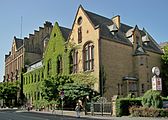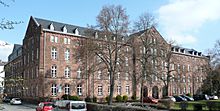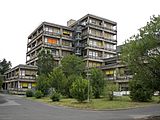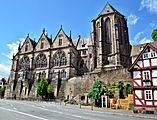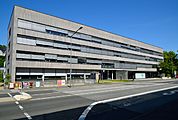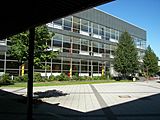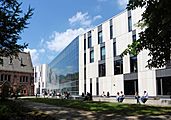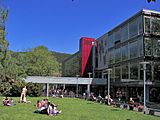University of Marburg facts for kids
|
Philipps-Universität Marburg
|
|
| Latin: Schola Marpurgensis | |
| Type | Public |
|---|---|
| Established | 1 July 1527 |
| Budget | €335.6 million |
| Chancellor | Claas Cordes |
| President | Thomas Nauss [de] |
|
Academic staff
|
2,657 |
|
Administrative staff
|
1,794 |
| Students | 22,380 |
| Location | , , |
| Campus | University town |
| Affiliations | Compostela Group of Universities |
The Philipps University of Marburg is a public university in Marburg, Germany. It was started in 1527 by Philip I, Landgrave of Hesse. This makes it one of Germany's oldest universities. It is also the oldest university that was founded as a Protestant school and is still open today.
The university has about 23,500 students and 7,500 staff members. Marburg is a town of 76,000 people. Many university buildings are located in or near the town center. About 14% of the students come from other countries. This is the highest percentage in the German state of Hesse. The university offers special summer programs for international students. It also has student exchange programs like the Erasmus programme.
Contents
University History and Milestones
The Philipps University of Marburg has a long and interesting history. It has been a place of learning for almost 500 years.
Early Discoveries in Chemistry
In 1609, the University of Marburg created the world's first special teaching position for chemistry. This shows how important science was to the university early on. In 2012, the university opened a fun, interactive chemistry museum called Chemicum. This museum helps young people get excited about science and maybe even choose a science career. The university was also one of the first in Germany to offer courses about gender studies.
The University During Difficult Times
During the Nazi period, in 1933, some professors were forced to leave the university. For example, economist Wilhelm Röpke had to leave Germany.
Growth After World War II
After 1945, the university continued to grow. Since the 1970s, its Department of Social Sciences became very well known. A professor named Wolfgang Abendroth was a big influence in political science during this time.
What Students Study and Research
The university is known for its strong academic programs and important research.
Important Research Areas
The university is very good at research in life sciences. This includes subjects like biology and medicine. It also has one of the few centers that studies the Middle East. This center is called the CNMS, which stands for Center for Near and Middle Eastern Studies. The psychology and geography departments were recognized as "Excellence Groups" in a European ranking in 2009.
The university takes part in special research projects called SFBs (Sonderforschungsbereiche). These are like big team projects. They are paid for by the German Science Foundation (DFG). These projects encourage researchers from different subjects to work together. This helps them discover new things. Some of these projects include:
- SFB/TR17 – Research on cancer pathways (started 2004)
- SFB/TR22 – Studies on allergic reactions in the lung (started 2005)
- SFB/TR81 – Research on cell changes in diseases (started 2010)
- SFB-TRR 84 – Studies on the body's natural defenses in the lung (started 2010)
- SFB-TRR 135 – Research on how we perceive things (started 2014)
- SFB 593 – Studies on how cells are organized and related to disease (started 2003)
- SFB 987 – Research on tiny living things and how they react to signals (started 2012)
- SFB 1083 – Studies on how different materials connect (started 2013)
- SFB 1021 – Research on RNA viruses and how they affect the body (started 2013)
University Collections and Museums
The university has many interesting collections and museums. These are great places to learn and explore:
- Alter Botanischer Garten Marburg, the university's old plant garden
- Botanischer Garten Marburg, the university's current plant garden
- Forschungsinstitut Lichtbildarchiv älterer Originalurkunden bis 1250 (A collection of old photos of medieval documents)
- Bildarchiv Foto Marburg (A German national picture archive of art)
- Religionskundliche Sammlung (A collection of religious objects)
- Deutscher Sprachatlas (A map showing different German dialects)
- Mineralogisches Museum (A museum of minerals)
- Museum für Kunst und Kulturgeschichte (A museum of art and cultural history)
- Museum Anatomicum (A museum about anatomy and medical history)
University Rankings and Reputation
| University rankings | ||||||||||
|---|---|---|---|---|---|---|---|---|---|---|
| Overall – Global & National | ||||||||||
|
||||||||||
Universities are often ranked to show how they compare to others around the world. In 2024, the Philipps University of Marburg was ranked globally between 761 and 770 by QS World University Rankings. In Germany, it was ranked 40th to 41st. The Times Higher Education World University Rankings also placed it globally between 401 and 500 in 2024. Nationally, it was ranked between 37th and 41st. The Academic Ranking of World Universities (ARWU) for 2023 listed the university globally between 401 and 500. In Germany, it was ranked between 25th and 31st.
Gallery
Famous People from the University
Many important people have studied or taught at Philipps University of Marburg.
Natural Scientists
- Ludwig Aschoff
- Emil von Behring
- Karl Ferdinand Braun
- Klaus Bringmann
- Robert Bunsen
- Adolf Butenandt
- Georg Ludwig Carius
- Stefanie Dehnen
- Franz Ludwig Fick
- Hans Fischer
- Edward Frankland
- Frederick Augustus Genth
- Johann Peter Griess
- Juan Gundlach
- Karl Eugen Guthe
- Otto Hahn
- Johannes Hartmann
- Thomas Archer Hirst
- Erich Hückel
- Kathrin Jansen
- Manfred Klüppel
- Hermann Knoblauch
- Hermann Kolbe
- Albrecht Kossel
- Ulrich Lemmer
- Otto Loewi
- Carl Ludwig
- Hans Meerwein
- Ludwig Mond
- Denis Papin
- Heinrich Petraeus
- Otto Schindewolf
- Thorsten M. Schlaeger
- Sunao Tawara
- John Tyndall
- Wilhelm Walcher
- Alfred Wegener
- Georg Wittig
- Alexandre Yersin
- Karl Ziegler
- Theodor Zincke
- Adolf Fick
Theologians
Marburg was always known for its focus on humanities. This includes subjects like philosophy and theology. It kept this strength for a long time after World War II.
- Rudolf Bultmann
- Karl Barth
- Andreas Leonhard Creuzer
- Friedrich Heiler
- Wilhelm Herrmann
- Aegidius Hunnius
- Andreas Hyperius
- Otto Kaiser
- Helmut Koester
- Jacob Lorhard
- Rudolf Otto
- Johann Jakob Pfeiffer
- Kurt Rudolph
- Annemarie Schimmel
- Paul Tillich
- August Friedrich Christian Vilmar
- Gottlieb Olpp
Philosophers
- Wolfgang Abendroth
- Hannah Arendt
- Karl Theodor Bayrhoffer
- Ernst Cassirer
- Hermann Cohen
- Hans-Georg Gadamer
- Nicolai Hartmann
- Martin Heidegger
- Hans Heinz Holz
- Hans Jonas
- Friedrich Albert Lange
- Karl Löwith
- Paul Natorp
- José Ortega y Gasset
- Isaac Rülf
- Leo Strauss
- Christian Wolff
- Eduard Zeller
- Jochen Ropke
Other Notable People
- Annette Henninger
- Ingeborg Weber-Kellermann
Alumni (Former Students)
- Kunigunde Bachl
- John Baillie (theologian)
- Hermann Behrends
- Gottfried Benn
- Gerold Bepler
- Jessie Forbes Cameron (1883–1968)
- Georg Friedrich Creuzer
- T. S. Eliot (who left a summer school in August 1914, when World War I began)
- Johannes Goddaeus
- Jacob Grimm
- Wilhelm Grimm
- Caspar Friedrich Hachenberg
- Gustav Heinemann
- de:Jost Hermand
- Beatrice Heuser
- Stefan Hofmann
- Kim Hwang-sik
- Wilhelm Liebknecht
- Mikhail Lomonosov
- Carlyle Ferren MacIntyre
- Ulrike Meinhof
- Friedrich Paulus
- Boris Pasternak
- Ernst Reuter
- Ferdinand Sauerbruch
- Friedrich Carl von Savigny
- Heinrich Schütz
- Moritz Schuppert
- Manfred Siebald
- Alfred Walter Stewart
- Wilhelm Röpke
- Costas Simitis
- Jack Thiessen
- Dmitry Ivanovich Vinogradov
- Richard Wiese (linguist)
See also
 In Spanish: Universidad de Marburgo para niños
In Spanish: Universidad de Marburgo para niños
- List of early modern universities in Europe
- List of universities in Germany
- University hospital Giessen und Marburg


